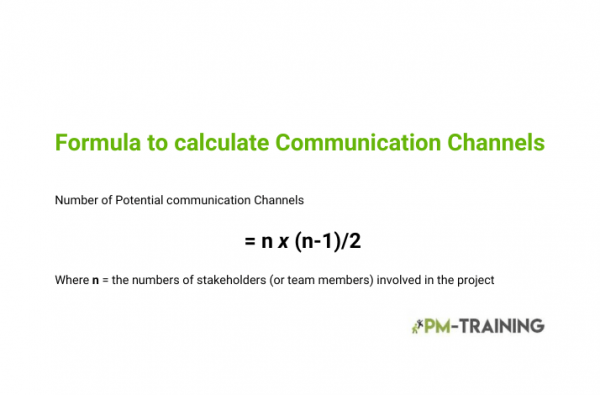In project management, communication is the process of passing information from one person to another. The aim of communication is to ensure that the receiver understands the message that the sender is trying to convey. Each communication channel has its own strengths and weaknesses, and each can be more or less effective depending on the situation.
Project managers use a variety of communication channels to communicate with stakeholders. This can include different channels like face-to-face meetings, telephone calls, emails, and presentations For example, face-to-face communication is generally more effective than email for complex or sensitive information. In contrast, email is very efficient, but it can be easy to misinterpret the sender’s intent.
- The importance of Communication Channels
- 5 most common communication Channels
- How to calculate communication Channels
- Easy Example of Communication Channels using the formula
- Communication Channel PMP Questions
- What are communication Channels?
- What are the 5 channels of communication?
- What is the formula for Communication Channels?
The importance of Communication Channels
In project management, communication is particularly important in order to ensure that all project stakeholders are kept up to date on the project’s progress and any changes that may occur. Especially to adapt to the necessary changes key team members would eventually need.
5 most common communication Channels
There are five primary communication channels in project management: video, instant messaging, telephone, email, and written. Each has its own strengths and weaknesses, and no single channel is ideal for all situations.

The best project managers know how to use all five communication channels effectively, depending on the situation. In some cases, a mix of channels may be needed to get the most important information across clearly and efficiently.

These are five main communication channels that are typically used in project management:
- Video communication
Because it brings together individuals who ordinarily would not be able to interact face-to-face, video conferencing is crucial. It means also reduced travel expenses, particularly for employee training, and shorter meeting and project timelines due to enhanced team interactions are some advantages of video conferencing
- Written communication
Written communication is one of the most important channels for project managers. This is because it provides a record of what was communicated, when it was communicated, and to whom it was communicated. This can be helpful when trying to track down information or resolve disagreements.
- Instant Messaging
Instant messaging and online chat are good for quick questions and short conversations, but they can be disruptive if you’re trying to focus on other tasks.
- Telephone communication
Phone calls are more personal and can be more easily tailored to the needs of the individual, but they are also more time-consuming.
- Email communication
An email is a great option for sending out updates and important documents, but it can be tough to have a back-and-forth conversation using this method.
The best project managers know how to use all five communication channels effectively, depending on the situation. In some cases, a mix of channels may be needed to get the most important information across clearly and efficiently.
How to calculate communication Channels
It is important to calculate the communication channels in project management in order to determine the most efficient way to communicate project updates to all stakeholders.
The Communication channels formula for calculating the number of communication channels required is Ch = N(N-1)/2.
Where:
Ch = the number of communication channels
N = the number of stakeholders
With this information, project managers can determine the best way to communicate updates to all stakeholders in a timely and efficient manner.

Easy Example of Communication Channels using the formula
In order to calculate the communication channels in a project, you first need to determine the number of team members. This can be done by multiplying the number of project roles by the number of people who fill those roles.
Once you have the number of team members, you need to calculate the number of communication channels. This can be done by multiplying the number of team members by the number of project stakeholders.
For example, let’s take a look at how it would look with 6 team members.

Communication Channel PMP Questions
1. You are managing a telecommunication project and 10 Quality engineers are reporting to the project manager. Due to a change in scope requested by your customer you need to add a team member. You decide to hire 2 more quality engineers. How many communication channels will be increased by this hiring?
A. 21
B. 23
C. 66
D. 78
Answer: B
2. Your project has 13 stakeholders, including the project team. Calculate the total number of communication channels for the project.
A. 78
B. 80
C. 13
D. 91
Answer: A
3. There are two software developers, two quality engineers, 3 database engineers, and 1 product owner in your team. Calculate the number of communication channels
A. 40
B. 36
C. 28
D. 22
Answer: B
What are communication Channels?
In short, they are the means by which information is exchanged between project managers and stakeholders. Along with key information to complete the project with important team members.
What are the 5 channels of communication?
There are 5 main communication channels that project managers can use, including email, instant messaging, phone calls, and video conferencing. Each of these has its own advantages and disadvantages, so it’s important to choose the right one for your needs.
What is the formula for Communication Channels?
The formula for calculating the number of communication channels can be expressed as Ch = N(N-1)/2. Where “N” is the number of stakeholders
